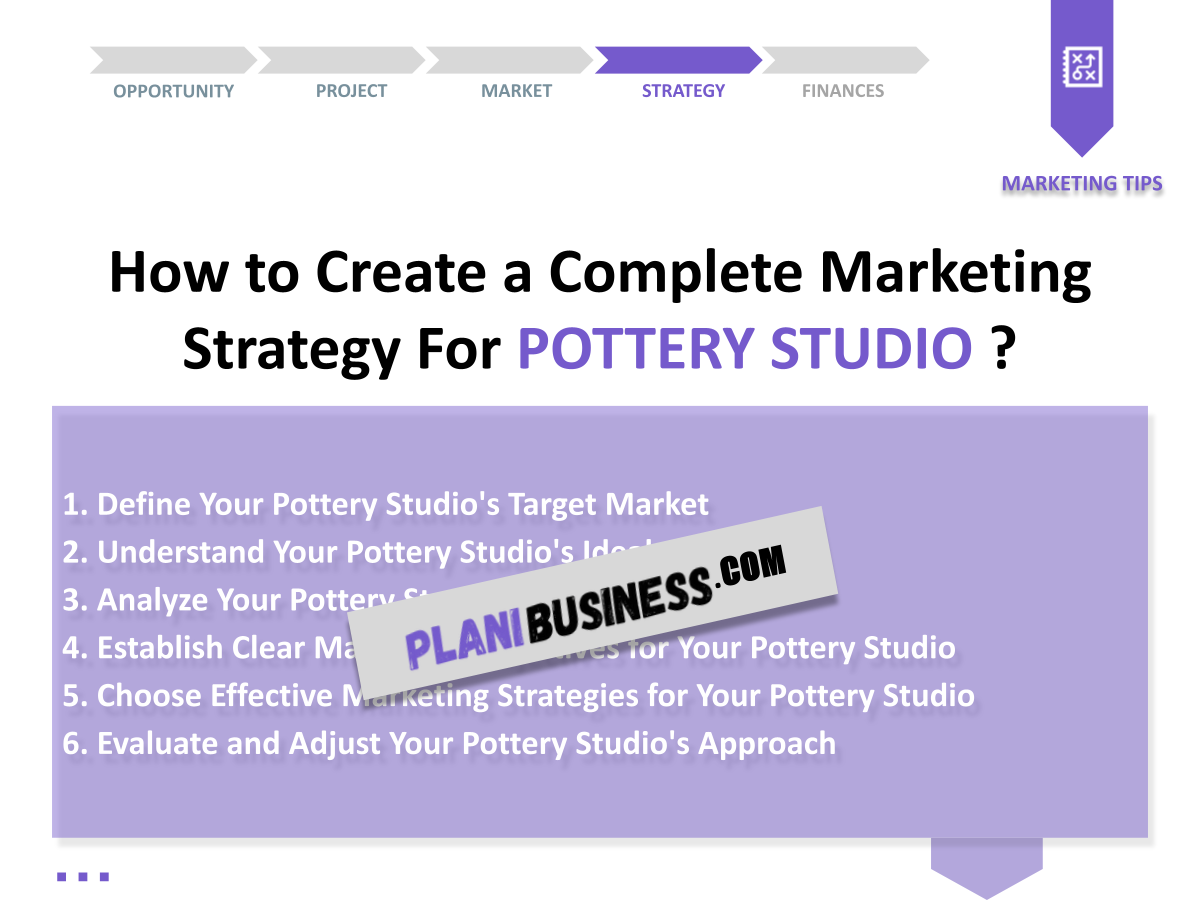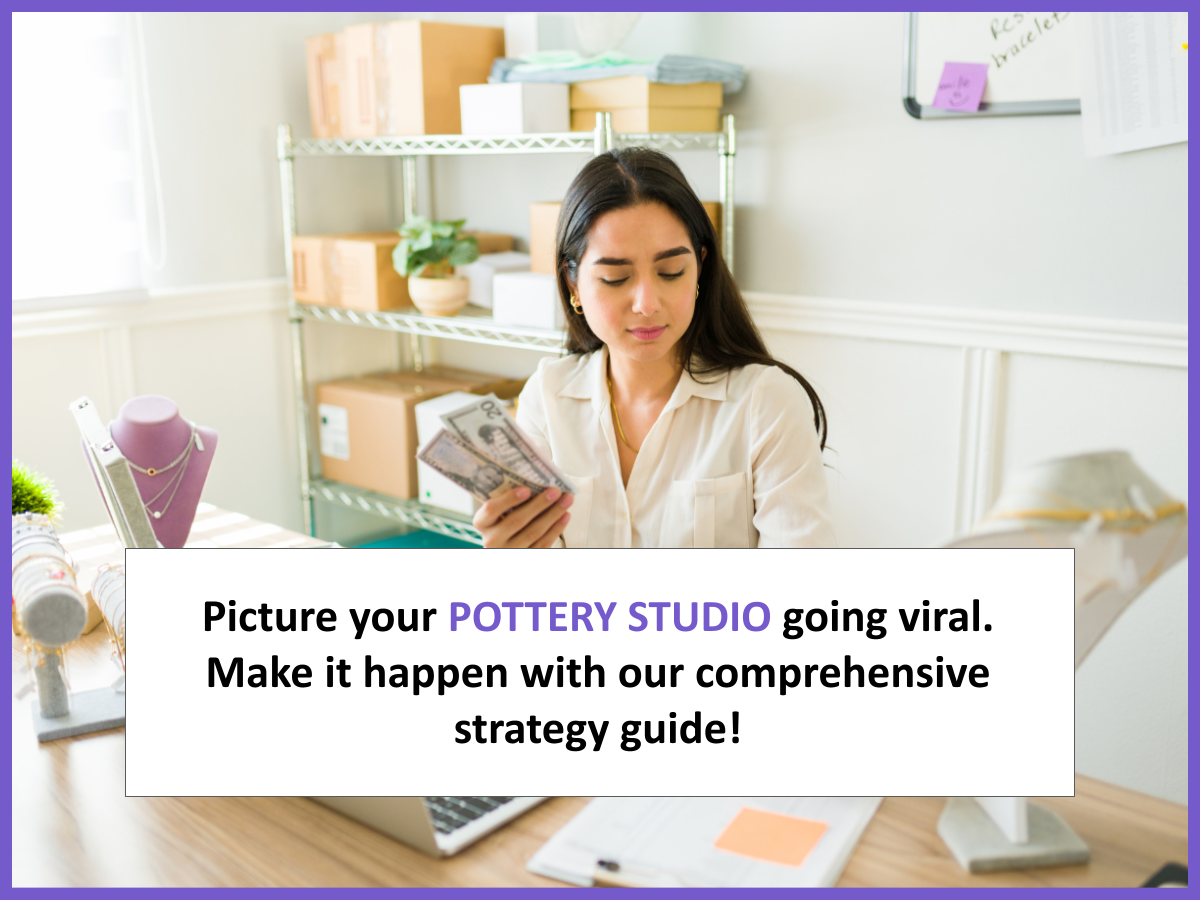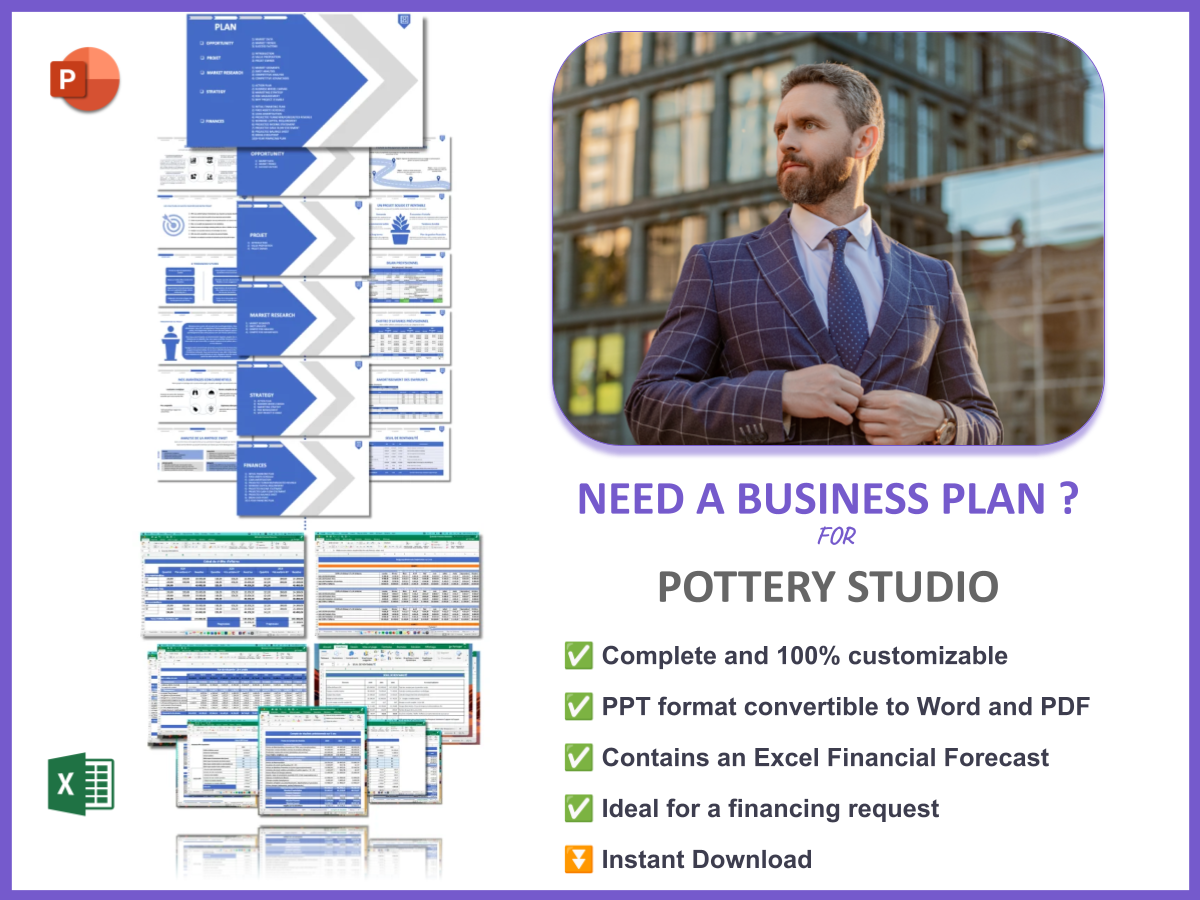Are you ready to transform your pottery passion into a thriving business? You’re not alone! Many pottery artists struggle with effectively marketing their studios and reaching their ideal customers. That’s where a well-crafted Pottery Studio Marketing Plan comes in. This plan is essential for guiding your marketing efforts and ensuring that you connect with the right audience.
Did you know that over 70% of small businesses fail within the first five years due to poor marketing strategies? That’s a staggering statistic, and it highlights the importance of having a solid plan in place. In this article, we’ll dive into how you can develop an effective Pottery Studio Marketing Plan, covering essential aspects like identifying your target market, understanding your ideal customers, analyzing competitors, and setting clear objectives.
Here’s a quick preview of what we’ll cover:
– Define your pottery studio’s target market
– Understand your pottery studio’s ideal customers
– Analyze your pottery studio’s competitors
– Establish clear marketing objectives for your pottery studio
– Choose effective marketing strategies for your pottery studio
– Evaluate and adjust your pottery studio’s approach
– Provide real-world examples of pottery studio marketing plans
1. Define Your Pottery Studio’s Target Market
| Segment | Demographics | Interests |
|---|---|---|
| Beginners | Ages 18-35, Local Residents | Creative Hobbies, DIY Projects |
| Art Enthusiasts | Ages 30-50, Art Collectors | Art Exhibitions, Local Art Scene |
| Gift Shoppers | All Ages, Gift Buyers | Unique Gifts, Handmade Products |
Understanding your target market is the first step in crafting a successful Pottery Studio Marketing Plan. This involves identifying the different segments of customers you aim to attract. Each segment has unique needs and interests, which you should consider when crafting your marketing strategy. For instance, beginners might be interested in workshops, while art enthusiasts may seek unique pieces for their collections. Gift shoppers are likely looking for special items to give on various occasions.
To identify your target market, consider conducting surveys or interviews with potential customers. You can also analyze social media trends to see what types of pottery are trending. This information will help you tailor your marketing messages and reach the right audience effectively.
2. Understand Your Pottery Studio’s Ideal Customers
| Characteristic | Description | Marketing Approach |
|---|---|---|
| Artistic | People who appreciate creativity and craftsmanship. | Highlight your unique creations. |
| Local | Community members who prefer shopping locally. | Engage through local events and workshops. |
| Gift Seekers | Individuals looking for unique gifts. | Market special occasions and gift options. |
When developing your Pottery Studio Marketing Plan, it’s essential to have a clear picture of your ideal customers. Knowing their characteristics helps tailor your messaging and promotions effectively. For example, if your ideal customer is artistic, you should emphasize the creativity behind your pottery and showcase your unique designs. If they are local community members, focus on building relationships through local events and workshops.
To better understand your ideal customers, you can create customer personas. These personas represent different segments of your target market and include details like demographics, interests, and buying behaviors. This approach will help you visualize who you’re marketing to and ensure your strategies resonate with them.
3. Analyze Your Pottery Studio’s Competitors
| Competitor | Strengths | Weaknesses |
|---|---|---|
| Competitor A | Strong online presence | High prices |
| Competitor B | Unique product offerings | Poor customer service |
| Competitor C | Established brand | Limited marketing |
Competitor analysis is a crucial step in your Pottery Studio Marketing Plan. By understanding who your competitors are, you can identify gaps in the market and refine your strategies to differentiate yourself. Start by making a list of local pottery studios and online shops that offer similar products.
Examine their strengths and weaknesses. For instance, if Competitor A has a strong online presence but charges high prices, you could position your studio as a more affordable option while maintaining quality. If Competitor B has unique offerings but struggles with customer service, ensure that your studio excels in providing excellent customer support.
Gathering this information can be done through online research, visiting competitors’ stores, and reading customer reviews. Use this analysis to inform your marketing strategies, ensuring you highlight what makes your pottery studio unique and valuable to customers.
4. Establish Clear Marketing Objectives for Your Pottery Studio
| Objective | Details | Timeline |
|---|---|---|
| Increase Sales | Boost monthly sales by 20% | Next 6 months |
| Grow Online Presence | Increase website traffic by 50% | Next 3 months |
| Build Community Engagement | Host 5 local workshops | Next year |
Your Pottery Studio Marketing Plan should have clear, measurable objectives. Establishing specific goals helps guide your strategies and measure your success over time. For example, if your objective is to increase sales, set a specific percentage, such as boosting monthly sales by 20% within the next six months.
Additionally, consider other objectives like growing your online presence by increasing website traffic by 50% over the next three months. Another key objective could be building community engagement by hosting five local workshops within the year. Each of these goals should be realistic and aligned with your overall business strategy.
To keep track of your progress, regularly review your objectives and adjust them as necessary. This ongoing evaluation will help ensure that your marketing efforts remain focused and effective.
5. Choose Effective Marketing Strategies for Your Pottery Studio
| Strategy | Details | Expected Outcome |
|---|---|---|
| Social Media Marketing | Engage followers with behind-the-scenes content. | Increased brand awareness. |
| Email Campaigns | Send monthly newsletters with promotions. | Higher customer retention. |
| Community Events | Participate in local fairs and markets. | Attract new customers. |
Choosing the right marketing strategies is crucial for your Pottery Studio Marketing Plan. These strategies should align with your objectives and resonate with your target audience. One effective approach is social media marketing. Engaging your followers with behind-the-scenes content can create a personal connection and boost brand awareness.
Consider platforms like Instagram and Facebook, where visuals play a significant role. Share photos of your pottery-making process, customer testimonials, and completed pieces to draw in potential customers. This not only showcases your talent but also humanizes your brand.
Another strategy is to implement email campaigns. Sending monthly newsletters that include promotions, new product announcements, or pottery tips can keep your studio top-of-mind for customers. Aim for high-quality content that adds value to your subscribers, which in turn can lead to higher customer retention.
Finally, participating in community events such as local fairs and markets can help attract new customers. These events provide an opportunity to showcase your work, engage with potential buyers, and create a sense of community around your pottery studio. Don’t forget to collect contact information from interested customers for future marketing efforts!
6. Evaluate and Adjust Your Pottery Studio’s Approach
| Metric | Measurement | Adjustment |
|---|---|---|
| Sales Growth | Monthly sales figures | Increase marketing spend if underperforming. |
| Website Traffic | Google Analytics reports | Optimize SEO if traffic is low. |
| Customer Feedback | Surveys and reviews | Make product adjustments based on feedback. |
Regular evaluation is essential in your Pottery Studio Marketing Plan. By consistently measuring your performance, you can make informed adjustments to your strategies. Start by tracking key metrics such as sales growth, website traffic, and customer feedback.
For instance, monitor your monthly sales figures. If you notice a decline, consider increasing your marketing spend to drive more traffic. Use tools like Google Analytics to track your website traffic. If the numbers aren’t meeting your expectations, it might be time to optimize your SEO strategies to attract more visitors.
Lastly, don’t underestimate the power of customer feedback. Collect insights through surveys or reviews and use this information to make necessary adjustments to your products or services. Listening to your customers can lead to improvements that enhance their experience and increase loyalty.
7. Example N°1 of Marketing Plan for Pottery Studio
| Steps | Actions | Details |
|---|---|---|
| 1 | Target Market | Identify local art enthusiasts. |
| 2 | Ideal Customers | Focus on community members interested in pottery. |
| 3 | Competitors | Analyze local pottery studios. |
| 4 | Marketing Objectives | Set a goal to increase workshop attendance by 30%. |
| 5 | Marketing Strategies | Utilize social media to promote events. |
| 6 | Evaluation | Track attendance and customer feedback. |
Example N°1 illustrates a focused approach for a pottery studio’s marketing plan. This plan targets local art enthusiasts and aims to boost workshop attendance by 30%. Start by identifying your target market, which includes community members interested in pottery. Then, analyze local competitors to understand what they offer and how you can stand out.
Establish clear marketing objectives that are measurable and time-bound. In this case, the goal is to increase workshop attendance. To achieve this, utilize social media marketing to promote upcoming events. Share engaging content that highlights the fun and creativity of your workshops.
Finally, track attendance and gather customer feedback to evaluate the effectiveness of your marketing efforts. This information will be invaluable for future planning and adjustments.
8. Example N°2 of Marketing Plan for Pottery Studio
| Steps | Actions | Details |
|---|---|---|
| 1 | Target Market | Identify gift shoppers looking for unique items. |
| 2 | Ideal Customers | Focus on individuals seeking artisan gifts. |
| 3 | Competitors | Review competitors’ gift offerings. |
| 4 | Marketing Objectives | Increase online sales by 25% in the next quarter. |
| 5 | Marketing Strategies | Implement targeted ads on social media. |
| 6 | Evaluation | Monitor online sales and adjust ads accordingly. |
Example N°2 focuses on attracting gift shoppers who are looking for unique items. The first step is to identify your target market, which consists of individuals seeking artisan gifts. Next, review what your competitors are offering to find a niche or unique selling proposition for your pottery studio.
Set a clear marketing objective to increase online sales by 25% over the next quarter. To achieve this, implement targeted ads on social media platforms where your audience is most active. Make sure to showcase your unique pottery pieces and highlight any special promotions.
Finally, monitor your online sales closely and be ready to adjust your ads based on performance. This flexibility will help you maximize your marketing efforts and reach your sales goals.
9. Example N°3 of Marketing Plan for Pottery Studio
| Steps | Actions | Details |
|---|---|---|
| 1 | Target Market | Identify families interested in creative activities. |
| 2 | Ideal Customers | Focus on parents looking for family-friendly activities. |
| 3 | Competitors | Analyze local family-oriented studios. |
| 4 | Marketing Objectives | Host family workshops and increase participation by 40%. |
| 5 | Marketing Strategies | Promote workshops through local schools and community centers. |
| 6 | Evaluation | Collect feedback from participants to improve future events. |
Example N°3 showcases a strategy aimed at attracting families interested in creative activities. The first step is to identify your target market, which includes parents seeking family-friendly experiences. Understanding their needs is crucial for creating appealing workshops that engage both kids and adults.
Next, focus on your ideal customers. Parents are looking for activities that not only entertain but also foster creativity in their children. By highlighting the fun and educational aspects of your pottery workshops, you can effectively attract this audience.
Set a clear marketing objective to host family workshops and increase participation by 40%. To achieve this, promote your events through local schools and community centers. These channels are often the best ways to reach families in your area.
Finally, after each workshop, collect feedback from participants to evaluate the success of your events. This input will be invaluable for improving future workshops and ensuring they meet your customers’ expectations.
10. Example N°4 of Marketing Plan for Pottery Studio
| Steps | Actions | Details |
|---|---|---|
| 1 | Target Market | Identify art collectors interested in unique pieces. |
| 2 | Ideal Customers | Focus on individuals who value craftsmanship. |
| 3 | Competitors | Research local galleries and studios. |
| 4 | Marketing Objectives | Increase gallery showings by 50%. |
| 5 | Marketing Strategies | Collaborate with local art events. |
| 6 | Evaluation | Assess sales and visitor feedback from gallery events. |
Example N°4 focuses on engaging with art collectors who appreciate unique pottery pieces. Begin by identifying your target market, specifically those who are interested in high-quality, handcrafted items. Understanding their preferences will help you create pieces that resonate with them.
Next, narrow down your ideal customers to individuals who value craftsmanship and artistry. Highlight the unique aspects of your work that set it apart from mass-produced items, emphasizing the personal touch in each piece.
Set a clear marketing objective to increase your gallery showings by 50%. Collaborate with local art events, such as exhibitions or fairs, where you can showcase your pottery. This strategy will not only attract potential buyers but also build your reputation within the art community.
Finally, evaluate your efforts by assessing sales and gathering visitor feedback from gallery events. This feedback will guide future marketing initiatives and help you refine your approach to better meet your customers’ needs.
11. Example N°5 of Marketing Plan for Pottery Studio
| Steps | Actions | Details |
|---|---|---|
| 1 | Target Market | Identify local businesses seeking unique decor. |
| 2 | Ideal Customers | Focus on shops and cafes looking for artisan products. |
| 3 | Competitors | Evaluate local businesses supplying decor. |
| 4 | Marketing Objectives | Establish partnerships with 10 local businesses. |
| 5 | Marketing Strategies | Offer wholesale pricing for bulk orders. |
| 6 | Evaluation | Monitor sales and partnership satisfaction. |
Example N°5 illustrates a marketing plan focused on B2B relationships by targeting local businesses that seek unique decor items. Start by identifying your target market, specifically shops and cafes that value artisan products. This niche can provide steady sales if approached correctly.
Your ideal customers in this scenario are businesses looking for distinctive decor to enhance their ambiance. By offering them unique pottery pieces, you can fulfill their need for quality and originality. To stand out, evaluate what your competitors are providing and ensure your offerings have unique features or designs.
Set a clear marketing objective to establish partnerships with at least 10 local businesses. To encourage these partnerships, consider offering wholesale pricing for bulk orders. This strategy not only increases your sales but also builds strong relationships with local establishments.
Finally, regularly monitor your sales and assess the satisfaction of your partners. Feedback from these businesses can provide insights into how to improve your product offerings and marketing strategies.
12. Example N°6 of Marketing Plan for Pottery Studio
| Steps | Actions | Details |
|---|---|---|
| 1 | Target Market | Identify tourists visiting the area. |
| 2 | Ideal Customers | Focus on travelers seeking unique souvenirs. |
| 3 | Competitors | Examine tourist-oriented shops and studios. |
| 4 | Marketing Objectives | Increase tourist sales by 30% during peak seasons. |
| 5 | Marketing Strategies | Advertise in local tourism brochures. |
| 6 | Evaluation | Track sales data during tourist seasons. |
Example N°6 focuses on attracting tourists visiting your area. The first step is to identify your target market, which includes travelers looking for unique souvenirs to take home. This audience is often eager to purchase locally-made items that reflect their travel experiences.
Your ideal customers are those seeking distinctive, handcrafted pottery as a memorable keepsake. To capture their attention, examine what your competitors in tourist-oriented shops and studios are offering. Differentiate your products by emphasizing unique designs or local themes.
Set a clear marketing objective to increase tourist sales by 30% during peak seasons. To achieve this, consider advertising in local tourism brochures and collaborating with hotels and travel agencies that can recommend your studio to their guests.
Finally, track your sales data during tourist seasons to evaluate the effectiveness of your strategies. This information will help you refine your marketing approach for future seasons.
13. Example N°7 of Marketing Plan for Pottery Studio
| Steps | Actions | Details |
|---|---|---|
| 1 | Target Market | Identify eco-conscious consumers. |
| 2 | Ideal Customers | Focus on individuals who prioritize sustainability. |
| 3 | Competitors | Research competitors with eco-friendly offerings. |
| 4 | Marketing Objectives | Launch a line of sustainable pottery. |
| 5 | Marketing Strategies | Promote the eco-friendly aspect on social media. |
| 6 | Evaluation | Gather customer feedback on the new line. |
Example N°7 illustrates a niche marketing approach targeting eco-conscious consumers. Start by identifying your target market, which consists of individuals who prioritize sustainability in their purchasing decisions. This audience is increasingly seeking products that align with their values.
Your ideal customers are those who appreciate eco-friendly practices and are willing to invest in sustainable products. Research what your competitors are offering in terms of eco-friendly pottery to find gaps in the market that you can fill.
Set a clear marketing objective to launch a new line of sustainable pottery. To promote this line, leverage social media platforms to highlight the eco-friendly aspects of your products, such as materials used and sustainable practices employed in your studio.
Finally, gather customer feedback on the new line to assess its reception in the market. This feedback will be essential for refining your product offerings and marketing strategies moving forward.
Conclusion
In summary, developing a comprehensive Pottery Studio Marketing Plan is crucial for successfully promoting your pottery business and reaching your target audience. By understanding your market, defining your ideal customers, analyzing competitors, and establishing clear marketing objectives, you can create effective strategies that drive growth.
Don’t forget to evaluate and adjust your approach regularly to ensure ongoing success. If you’re looking for a solid foundation to start your pottery studio, consider utilizing a well-structured business plan template for your Pottery Studio, which you can find here.
Additionally, if you’re interested in learning more about setting up your pottery studio, check out our article on How to Set Up a Pottery Studio?. For those looking to analyze their business position, our article on creating a SWOT analysis for Pottery Studio is also a great resource. Equip yourself with the right knowledge and tools to make your pottery studio a success!
FAQ
- What is a Pottery Studio Marketing Plan?
A Pottery Studio Marketing Plan outlines strategies and tactics to promote your pottery business, attract customers, and achieve sales goals. - How do I identify my target market for my pottery studio?
Identify your target market by researching demographics, interests, and purchasing behavior of potential customers. Consider factors like age, location, and art appreciation. - What marketing strategies can I use for my pottery studio?
Effective marketing strategies include social media marketing, email campaigns, community events, and collaborations with local businesses. - How can I analyze my competitors in the pottery market?
Analyze competitors by researching their offerings, strengths, weaknesses, and customer reviews. This will help you identify gaps in the market and improve your own offerings. - What are some common marketing objectives for a pottery studio?
Common marketing objectives include increasing sales, growing online presence, and building community engagement through workshops and events. - How do I measure the success of my pottery studio marketing plan?
Measure success by tracking key metrics such as sales growth, website traffic, customer feedback, and workshop attendance. - What should I include in my pottery studio marketing plan?
Include sections on target market analysis, competitor analysis, marketing objectives, marketing strategies, and evaluation methods. - How often should I update my pottery studio marketing plan?
Regularly review and update your marketing plan at least every six months to ensure it remains relevant and effective. - Can I use social media to promote my pottery studio?
Absolutely! Social media is a powerful tool for promoting your pottery studio, showcasing your work, and engaging with potential customers. - What are the benefits of hosting workshops in my pottery studio?
Hosting workshops can increase community engagement, attract new customers, and create additional revenue streams for your pottery studio.







